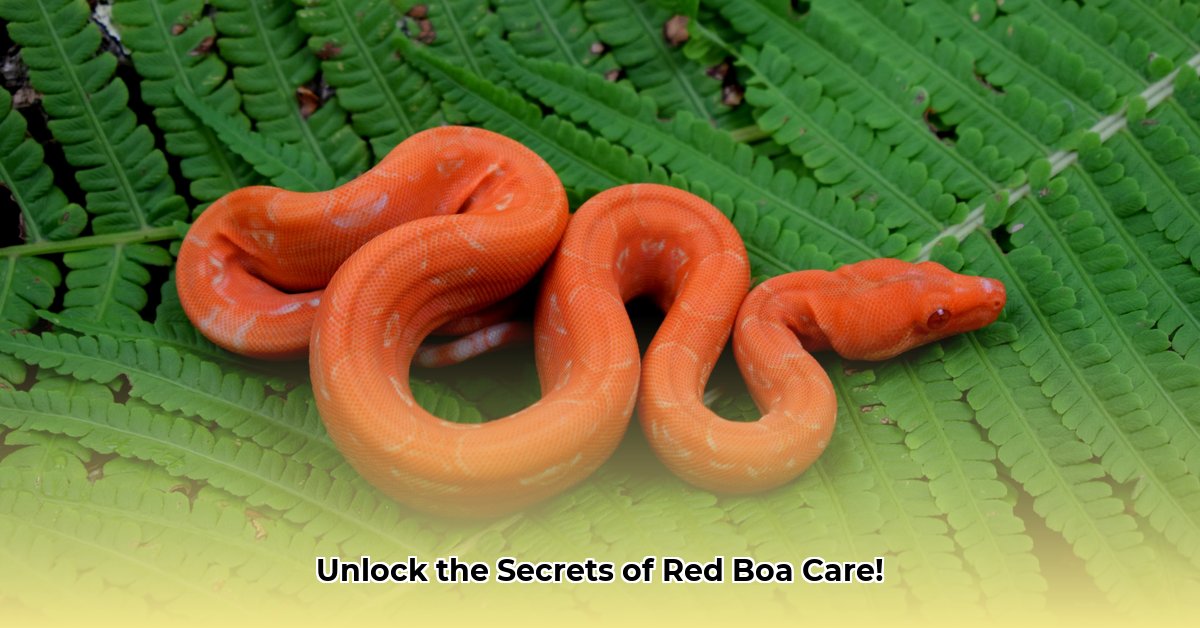Understanding the Majestic Red Boa Constrictor
Bringing a red boa constrictor into your home is a rewarding experience, connecting you with a fascinating creature of the rainforest. These impressive snakes, native to South America, can be captivating companions, but responsible ownership demands a deep understanding of their specific needs. This guide provides the essential knowledge to ensure your red boa thrives under your care. From habitat setup and feeding to health management and understanding their unique behaviors, we’ll cover everything you need to know.
Crafting the Perfect Red Boa Habitat
Replicating the natural rainforest environment is crucial for your red boa’s well-being. Consider these key elements:
-
Enclosure Size: A Growing Home: Start young boas in a 4x2x2 foot enclosure. As they grow, reaching lengths of 6 to 11 feet, upgrade to a significantly larger enclosure, ideally 8x4x4 feet or even more spacious. Adequate space is essential for natural movement, thermoregulation, and overall health. Cramped conditions can induce stress and hinder proper development.
-
Substrate: The Foundation of Comfort: Opt for aspen shavings, cypress mulch, or reptile carpet as suitable substrates. Avoid cedar or pine shavings, as the aromatic oils released by these woods can cause respiratory issues in your boa. The substrate should be easy to clean and maintain a healthy level of humidity.
-
Temperature: The Gradient of Well-being: Maintaining a temperature gradient within the enclosure is essential. The warm side should range from 88-92°F (31-33°C), while the cool side should be maintained at 78-82°F (26-28°C). A reliable thermometer is crucial for accurate monitoring. This gradient allows your boa to thermoregulate effectively, moving between warmer and cooler areas as needed.
-
Humidity: The Breath of the Rainforest: Replicating the humid rainforest environment is paramount. Aim for a humidity level between 60-80%, employing a hygrometer for accurate monitoring. Regular misting and a large, accessible water bowl will help maintain optimal humidity. Insufficient humidity can lead to dehydration, shedding difficulties, and respiratory problems.
-
Hiding Places: Sanctuaries of Security: Red boas are naturally shy creatures, requiring ample hiding spots to feel secure and reduce stress. Provide at least two hiding places, one on each side of the temperature gradient. These can include commercially available reptile hides, hollow logs, or even strategically placed foliage. These safe havens promote a sense of well-being and reduce the likelihood of stress-related illnesses.
-
Enrichment: Stimulating Natural Behaviors: Beyond the basics, enriching your boa’s environment is vital for its mental and physical health. Provide sturdy branches for climbing, simulating their arboreal nature. Incorporate foliage and other natural elements to create a more stimulating and engaging environment. This encourages natural behaviors like exploration and climbing, contributing to a healthier and more active boa.
Nourishing Your Red Boa: A Balanced Diet
A proper diet is the cornerstone of your red boa’s health. Follow these guidelines for optimal nutrition:
-
Baby Boas: Small Beginnings: Start young boas with appropriately sized pinky or fuzzy mice. Ensure the prey is easily manageable and digested.
-
Adults: Graduated Growth: As your boa grows, gradually increase the prey size, progressing from small mice to larger mice, rats, and eventually rabbits for larger adults. The prey should never be thicker than the widest part of your boa’s body. Oversized prey can cause regurgitation, digestive problems, and even injury.
-
Frequency: Finding the Right Rhythm: Feeding frequency depends on the boa’s age, size, and individual metabolism. Young, rapidly growing boas require more frequent meals compared to adults. Adults may only need feeding every two weeks or even less frequently. Monitor your boa’s weight and adjust the feeding schedule as needed to maintain a healthy body condition.
-
Feeding Practices: Safe and Stress-Free: Always offer pre-killed prey to eliminate the risk of injury to your boa. Feeding in a separate enclosure can help prevent accidental ingestion of substrate and reduce the likelihood of your boa associating your hand with food. Create a calm and quiet environment during feeding time to minimize stress.
Safeguarding Your Red Boa’s Health: Proactive Measures
Preventive care is key to maintaining your red boa’s well-being. Implement these strategies for a healthy and thriving snake:
-
Environmental Stability: The Foundation of Health: Consistent temperature and humidity gradients are crucial for a strong immune system. Fluctuations can weaken the boa’s defenses, making it more susceptible to illness.
-
Spacious Living: Reducing Stress: Ample space minimizes stress, a significant factor in immune system compromise. Provide the largest enclosure possible to allow for natural movement and exploration.
-
Hygienic Substrate: Preventing Infections: Choose an easily cleaned substrate like paper towels or reptile carpet to minimize the risk of bacterial or fungal growth. Avoid substrates that can be easily ingested, potentially leading to impaction.
-
Regular Cleaning and Disinfection: Regular cleaning and disinfection of the enclosure are essential for preventing infections. Spot clean daily, removing any waste or uneaten prey. Conduct a thorough cleaning and disinfection of the entire enclosure at least once a month.
-
Quarantine for New Arrivals: Always quarantine new boas for a minimum of 30 days. This crucial step prevents the spread of potential diseases to your existing collection. Observe the new boa closely for any signs of illness during the quarantine period.
-
Veterinary Care: Expert Guidance: Regular checkups with a reptile specialist are vital for your boa’s health. A veterinarian can detect early signs of illness, provide tailored advice, and address any health concerns promptly.
By diligently following these guidelines, you’ll be well-equipped to provide your red boa with the care and environment it needs to thrive in captivity. Remember, responsible ownership involves ongoing learning and adaptation to meet your boa’s individual needs. Building a strong bond with your red boa constrictor will enrich both your lives, offering years of fascinating companionship.
















